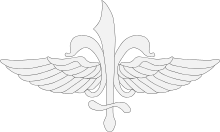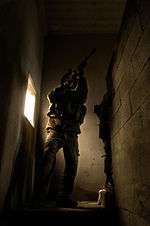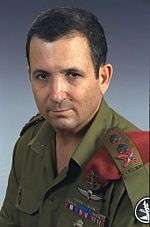Sayeret Matkal
| Sayeret Matkal | |
|---|---|
 | |
| Active | 1957–present |
| Country |
|
| Branch | Military Intelligence Directorate |
| Type | Special operations force |
| Role |
Special reconnaissance Direct action (military), Raid (military) Hostage rescue Counter-terrorismand more. |
| Size | Classified. |
| Nickname(s) | The Unit |
| Motto(s) | "Who dares wins" |
| Engagements |
War of Attrition Yom Kippur War 1982 Lebanon War First Intifada Second Intifada 2006 Lebanon War |
| Commanders | |
| Notable commanders |
Ehud Barak Yonatan Netanyahu Nehemiah Tamari Uzi Dayan Moshe Yaalon |
Sayeret Matkal (Hebrew: סיירת מטכ"ל, General Staff Reconnaissance Unit) is a special forces unit of the Israel Defense Forces (IDF). First and foremost a field intelligence-gathering unit, conducting deep reconnaissance behind enemy lines to obtain strategic intelligence, Sayeret Matkal is also tasked with counter-terrorism and hostage rescue beyond Israel's borders. The unit is modeled after the British Army's Special Air Service, taking the unit's motto "Who Dares, Wins". The unit is the Israeli equivalent of Delta Force of the United States and to the UK's Special Air Service. [1] It is directly subordinate to the IDF's Directorate of Military Intelligence.
History
In 1954 Israel's first special operations unit—Unit 101—was disbanded following the outcry provoked by the Qibya massacre. This left the IDF without a dedicated special-forces unit other than the Navy's Shayetet 13, a naval commando unit which could not fully replace Unit 101. In 1957 Avraham Arnan (né Herling), a former yeshiva student and Palmach fighter, petitioned the IDF General Staff to create a unit that could be dispatched to enemy-held territory to carry out top secret intelligence-gathering missions. Arnan's idea (backed by David Ben-Gurion and Yitzhak Rabin) was to create a unit that would recruit only the best and the brightest of Israeli youth. Prospective fighters were to be hand-picked, being physically and intellectually the best soldiers available. Originally part of Aman's Unit 157, Sayeret Matkal began to operate independently a year later as the General Staff's special operations force,[2] modeled after the British Special Air Service. Members of the unit were trained by Bedouin trackers in order to obtain a better understanding of their adversaries.[3] Established a year after the formation of Israel's first helicopter squadron, the close co-operation between the two units allowed Sayeret Matkal to deploy longer and deeper inside Arab territory than its predecessor. Arnan's vision for Sayeret Matkal (of which he was the first commander) was of a unit that would carry out strategic intelligence-gathering and other operations; as such it would receive its missions only from the General Staff. Sayeret Matkal would also evaluate new weapons and doctrines that could influence the entire IDF.[4]
Due to the extensive training, planning and preparation that had to be undertaken before its missions, Sayeret Matkal ended up not seeing any action during the Six-Day War. It was however engaged extensively in the following War of Attrition. After 1967, with the rise of Palestinian political violence perpetrated by groups such as the Palestine Liberation Organization (PLO), Sayeret Matkal began developing the first hostage-rescue and counter-terrorism techniques in the world. Beginning with Operation Isotope, the unit carried out several high-profile operations that thrust it into the limelight as an "elite paratroopers" unit (Sayeret Matkal's existence was classified at the time). In 1972, before the Munich massacre, Sayeret Matkal's operatives were sent to West Germany to cooperate with German authorities and, if necessary, perform the hostage-rescue themselves. Their advice though, was not heeded. In the subsequent Operation Wrath of God, Sayeret Matkal struck the PLO in Beirut.[5]
The Yom Kippur War in 1973 brought a profound change to the unit. With Israel fighting on two fronts and the General Staff busy with managing the war, Sayeret Matkal found itself without missions to perform. Sayeret Matkal officers then split into two camps: those who believed that the unit should be kept in reserve and not be lightly sent to missions where it could endure heavy casualties, and those that wanted to go into action, even if that meant missions with little planning and more akin to a commando force than to the strategic-oriented Sayeret Matkal. The latter prevailed and Sayeret Matkal was tasked with operations on both fronts. After the war, Sayeret Matkal began developing plans for wartime in advance, so that when war came, the unit could go into action immediately, without waiting for the General Staff's orders and missions. A reserve company of Sayeret Matkal was also designated specifically for cooperation with the Israeli Air Force, shown by the war to be lacking. This would later evolve into Shaldag Unit.[6]
In 1974 Sayeret Matkal suffered a heavy blow when a failed rescue attempt resulted in the Ma'alot massacre. The debacle led to the creation of the Yamam to deal with domestic counter-terrorism/hostage-rescue missions, while Sayeret Matkal would focus on foreign counter-terrorism/hostage-rescue. Two years later came the most famous mission of the unit when it spearheaded Operation Entebbe to rescue hostages held in Uganda. The mission was a resounding success, although there were 4 hostages killed as well as the commander of the Unit, Lieutenant Colonel Yonatan Netanyahu.[7]
Although a top-secret unit, Sayeret Matkal had tremendous influence on the IDF. It was the original developer of helicopter infiltration techniques in Israel. In addition, their extensive use of the Uzi led them to convince Israel Military Industries to produce an Uzi with a folding stock for increased accuracy while maintaining its small frame.
In 2015 the unit received a honorable mention for its activities during Operation Protective Edge. [8]
Recruitment and training

The unit was kept top-secret during its initial years. Fighters and commanders were selectively hand-picked, based on personal acquaintances. Since the 1970s, while still secretive, the unit opened to voluntary recruits. Twice a year it holds a notoriously grueling selection camp (Gibbush) for potential recruits lasting several sleepless days. The recruits are constantly monitored by doctors and psychologists. Those who make it through with a passing grade are admitted. During the 1990s, this selection practice was picked up by other IDF special forces (Sayeret). Former IDF Chief of Staff Dan Halutz planned to unify all such camps to prevent recruit burn-outs and medical injury by over-enthusiastic youths.[5]
Once admitted to the unit, recruits train for 18–19 months, with heavy emphasis on small arms, martial arts, navigation, camouflage, reconnaissance and other skills required for survival behind enemy lines. They must also complete the 120-kilometre (75 mi) Beret March in the final four days to receive their red beret.[5] The training regime consists of the following:
- Four months of basic infantry training, held in the Paratroopers basic training base; it is part of the regular Paratroopers basic training routine.[5]
- Two months advanced infantry training, within the unit.[5]
- Three weeks parachuting course in the IDF Parachuting School.[5]
- Five weeks counter-terror (CT) course in the IDF Counter-Terror Warfare School, followed by more inner-unit CT training.[5]
- The rest of the training is dedicated to long-range reconnaissance patrol training, and especially to navigation/orienteering, which is of vast importance in the unit. While most of the orienteering training is done in pairs for safety reasons, as in every other unit in the IDF, Sayeret Matkal is one of the handful of IDF units which conducts long-range solo navigation exercises.[5]
Although Sayeret Matkal has its own insignia, it is also one of the few units in the IDF whose soldiers are not allowed to wear it in public due to its classified nature. Ironically, this lack of insignia often leads to Sayeret Matkal operators being recognized as such, as the fact that Matkal troopers don't wear insignia is well known.[9]
Notable members

Sayeret Matkal veterans have gone on to achieve high positions in Israel's military and political echelons. Several have become IDF Generals and members of the Knesset. Ehud Barak's career is an example: a draftee in 1959, he later succeeded Unit 101 commando Lt. Meir Har-Zion in becoming Israel's most decorated soldier. While with Sayeret Matkal, Barak led operations Isotope in 1972 and Spring of Youth in 1973. He later advanced in his military career to become the IDF Chief of Staff between 1991 and 1995. In 1999 Ehud Barak became the 10th Prime Minister of Israel.[7]
- Uzi Yairi – Unit Commander, formerly head of the IDF Paratroopers Brigade, killed in action while off-duty during Savoy Operation.[7]
- Nechemya Cohen – The Unit's and the IDF's most decorated soldier (with Barak). Killed in action. Beit Nechemya was built in his memory by "the Unit".[10]
- Benjamin Netanyahu – unit team leader, MIT graduate, current (also former) Israeli Prime Minister.[7]
- Iddo Netanyahu – writer and radiologist. Benjamin Netanyahu's younger brother.[7]
- Yonatan Netanyahu – unit commander, killed in "Operation Thunderbolt" (Entebbe, Uganda). Benjamin Netanyahu's older brother.[7]
- Shaul Mofaz – unit deputy commander, later IDF Chief of Staff and Former Defense Minister of Israel.[7]
- Moshe Yaalon – unit commander, later IDF Chief of Staff, current Former Strategic Affairs Minister of Israel and current Defense Minister of Israel.[11]
- Danny Yatom – unit deputy commander, later a General, head of Mossad and a Knesset member.[12]
- Avi Dichter – unit fighter, later head of Israel's General Security Service (Shin Bet), later the minister of internal security.[12]
- Daniel M. Lewin – cofounder of Akamai Technologies. He was one of the first victims of the September 11 attacks.[13]
- Naftali Bennett – Leader of The Jewish Home party.[14]
- Doron Avital - commander 1992-1994. Member of 18th Knesset for Kadima.
There is a widely held misconception that former Israeli Major General and former Prime Minister Ariel Sharon served in Sayeret Matkal, though as a Major Sharon had founded the IDF's first special-forces unit (Unit 101) in 1953. When Unit 101 was merged into the Paratroopers Brigade in 1954, Sharon became brigade commander, but never served in Sayeret Matkal.
Alleged operations
- 1968 – Operation Gift – sabotage of 14 Arab airliners in Beirut International Airport, Lebanon.[15]
- 1969 – Operation Bulmus 6 – assault on fortified Green Island, Egypt (jointly with Shayetet 13).[16]
- 1972 – Operation Isotope – foiling the hijacking of Sabena Flight 571 in Tel Aviv, Israel (hostages rescue).[5][17]
- 1972 – Operation Crate 3 – kidnapping 5 Syrian intelligence officers.[5]
- 1973 – Operation Spring of Youth – killing Black September terrorist leaders in Beirut, Lebanon (jointly with Shayetet 13).[5]
- 1973 – Yom Kippur War – recapture of Mount Hermon from Syrian commandos (jointly with Golani Brigade); deep interdiction ambushes in Egypt and Syria.[9]
- 1974 – Ma'alot massacre – school hostages rescue.[7]
- 1975 – Savoy Operation – hotel hostages rescue.[7]
- 1976 – Operation Thunderbolt (Operation Jonathan) – hostage rescue following Air France aircraft hijacking to Entebbe, Uganda.[7][18]
- 1978 – Coastal Road Massacre – bus hostages rescue.[7][17]
- 1980 – Misgav Am hostage crisis – Kibbutz nursery hostages rescue.[17]
- 1982 – 1982 Lebanon War – deep reconnaissance ahead of Israeli forces (snipers managed to target Yasser Arafat although they were not allowed to fire)[19]
- 1984 – Kav 300 affair – bus hostages rescue, see the Shabak's years of crisis.[20]
- 1988 – Tunis Raid – assassination of Abu Jihad, in Tunis, Tunisia.[21]
- 1989 – Kidnapping of Sheik Abdul-Karim Obeid, Lebanon (see Ron Arad).[17]
- 1992 – Operation Bramble Bush – plan to assassinate Iraqi president Saddam Hussein.[22]
- 1994 – Mustafa Dirani kidnapping, Lebanon (see Ron Arad).[17]
- 1994 – Nachshon Wachsman – failed hostage rescue.[23]
- 2006 – Second Lebanon War: Operation Sharp and Smooth – disrupt weapons smuggling (jointly with the Shaldag Unit); other operations to disrupt weapons smuggling (in one of them the force was discovered and Lieutenant Colonel Emmanuel Moreno was killed and two others were wounded in the ensuing gun battle).[24]
- 2007 – Collecting soil samples in Syria prior to Operation Orchard, the bombing of an alleged Syrian nuclear reactor.[25]
See also
Israeli special forces:
- Sayeret
- Shayetet 13
- Sayeret Shaldag
- Sayeret Duvdevan
- Sayeret Yahalom (formerly Sayeret Yael)
- Unit 669
- YAMAM
Similar foreign special forces units:
References
- ↑ "Sayeret Matkal – Israeli Special Operations". Retrieved 2008-07-27.
- ↑ "The secret remains – Haaretz – Israel News". Haaretz. Retrieved 2010-03-09.
- ↑ "Sayeret Mat'kal". Specwarnet.net. Retrieved 2010-03-09.
- ↑ Betser, Muki (1996). Secret Soldier. London: Simon & Schuster. ISBN 0-684-81683-0.
- 1 2 3 4 5 6 7 8 9 10 11 Ryan, Mike (2008). The Operators: Inside the World's Special Forces. Skyhorse Pub. p. 134. ISBN 978-1-60239-215-1.
- ↑ Katz, Yaakov (August 13, 2006). "Israeli commando missions come out of shadows". The USA Today.
- 1 2 3 4 5 6 7 8 9 10 11 Dunstan, Simon (January 2011). Entebbe: The Most Daring Raid of Israel's Special Forces. The Rosen Publishing Group. pp. 12, 49–50. ISBN 978-1-4488-1868-6.
- ↑ http://www.ynet.co.il/articles/0,7340,L-4616797,00.html
- 1 2 Tucker, Spencer C.; Roberts, Priscilla (12 May 2008). The Encyclopedia of the Arab-Israeli Conflict: A Political, Social, and Military History [4 volumes]: A Political, Social, and Military History. ABC-CLIO. p. 738. ISBN 978-1-85109-842-2.
- ↑ Pressfield, Steven (6 May 2014). The Lion's Gate: On the Front Lines of the Six Day War. New York: Penguin Group US. p. 339. ISBN 978-0-698-16397-3.
- ↑ Kahana, Ephraim (19 April 2006). Historical Dictionary of Israeli Intelligence. Scarecrow Press. p. 309. ISBN 978-0-8108-6500-6.
- 1 2 Pedahzur, Ami (13 August 2013). The Israeli Secret Services and the Struggle Against Terrorism. Columbia University Press. pp. 1–4. ISBN 978-0-231-51161-2.
- ↑ Weiss, Efrat (12 September 2001). "Daniel was a very special man". Yedioth Ahronoth (in Hebrew). Ynet!. Retrieved 12 September 2011.
- ↑ Kinet, Ruth (2013). Israel: Ein Länderporträt. Ch. Links Verlag. p. 93. ISBN 978-3-86153-714-4.
- ↑ "The Risks of Israel's Two-Front War". Time. July 13, 2006. Retrieved May 30, 2008.
- ↑ Bawaba, Al (June 18, 2007). "Spotlight : Ami Ayalon". The Star (Amman, Jordan) – via HighBeam Research (subscription required) .
- 1 2 3 4 5 Geraghty, Tony (12 July 2011). Black Ops: The Rise of Special Forces in the C.I.A., the S.A.S., and Mossad. Pegasus Books. p. 277. ISBN 978-1-4532-1827-3.
- ↑ Blackburn, Michael (6 June 2013). US Army Special Forces Small Unit Tactics Handbook. Blacksmith Publishing. p. 183. ISBN 978-0-9895513-0-4.
- ↑ Muki Betser's "Secret Soldier"
- ↑ Hoffman, Aaron (September 22, 2011). "The Israeli Secret Services and the Struggle Against Terrorism". Shofar – via HighBeam Research (subscription required) .
- ↑ The New York Times http://www.nytimes.com/aponline/2012/11/01/world/middleeast/ap-ml-israel-assassination.html. Missing or empty
|title=(help) - ↑ Lavie, Mark (December 16, 2003). "Israelis plotted to kill Saddam". Deseret News – via HighBeam Research (subscription required) .
- ↑ Matthew Levitt (2008). Negotiating Under Fire: Preserving Peace Talks in the Face of Terror Attacks. Rowman & Littlefield Publishers. Retrieved June 23, 2014.
- ↑ Katz, Yakov (March 29, 2007). "Sayeret Matkal celebrates 50 years of courage, secrecy". The Jerusalem Post – via HighBeam Research (subscription required) .
- ↑ http://fr.jpost.com/servlet/Satellite?apage=1&cid=1220526712951&pagename=JPost/JPArticle/ShowFull